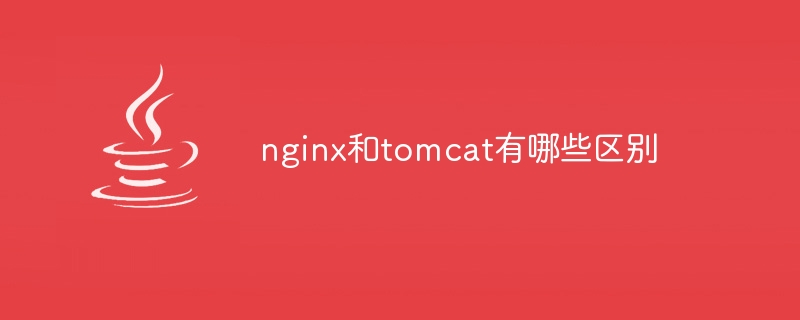Home >Java >javaTutorial >What are the differences between nginx and tomcat
What are the differences between nginx and tomcat
- 百草Original
- 2023-12-27 15:20:071162browse
The difference between nginx and tomcat: 1. Design and architecture; 2. Function and performance; 3. Deployment and management; 4. Usage scenarios; 5. Community and support. Detailed introduction: 1. Design and architecture. Nginx is a high-performance HTTP and reverse proxy server. It mainly receives, processes and forwards requests. Tomcat is a Java Web application server, specially used to deploy and manage Java Web applications. ; 2. Function and performance, Nginx mainly improves through reverse proxy and load balancing technology, etc.

The operating system for this tutorial: Windows 10 system, DELL G3 computer.
Nginx and Tomcat are two different web server software, each with unique characteristics and uses. The following are some of the main differences between Nginx and Tomcat:
1. Design and architecture:
Nginx is a high-performance HTTP and response server To the proxy server, it mainly receives, processes and forwards requests. It is an event-driven server that can handle a large number of concurrent connections and is particularly suitable for static content and high-concurrency scenarios.
Tomcat is a Java Web application server specifically used to deploy and manage Java Web applications. It is based on Java Servlet and JavaServer Pages (JSP) technology and can provide functions such as dynamic web content generation and database interaction.
2. Function and performance:
Nginx mainly uses reverse proxy and load balancing technology to improve the web server performance to achieve high concurrent access. It supports the HTTP/2 protocol and provides a module called stream to handle TCP/UDP traffic. In addition, Nginx also has powerful caching capabilities and streaming support.
Tomcat specializes in the deployment and management of Java web applications. It provides complete Java EE application server functions, including Servlet container, JSP engine, JavaMail, JNDI, etc. Tomcat also supports the HTTP/2 protocol and is scalable and flexible, allowing it to be customized and expanded as needed.
3. Deployment and management:
Nginx is usually deployed as a reverse proxy server, and the client can The request is forwarded to the internal web server or application server. It can be configured to use different load balancing algorithms and can be integrated with various caching systems.
Tomcat can run independently as a web server or be integrated with other web servers. It can deploy multiple web applications (WAR files) and has its own management interface and toolset to facilitate application management and maintenance.
4. Usage scenarios:
Nginx is often used as a Web browser due to its high performance and flexible configuration. The front-end server for your application, handling tasks such as static content, reverse proxying, and load balancing. It is also suitable for scenarios that require high concurrent connections and fast response, such as online shopping websites, social media platforms, etc.
Tomcat is more suitable for the deployment and management of Java Web applications. It provides a complete Java EE development environment suitable for developing, testing and deploying Java web applications. Many large enterprises and organizations use Tomcat as their application server, especially in the field of Java development.
5. Community and support:
Nginx has a large user community and active development team, providing Rich documentation, plug-ins and third-party tool support. Due to its widespread use and popularity, Nginx has extensive help and support available when you encounter problems.
Tomcat is maintained by the Apache Software Foundation and also has a large user community and a strong technical support system. Due to its close relationship with Java, Tomcat has extensive support and application in the Java developer community.
In summary, Nginx and Tomcat have significant differences in design and architecture, functionality and performance, deployment and management, usage scenarios, and community and support. Choosing which server to use depends on factors such as specific needs, performance requirements, development language, and team skills. In actual applications, Nginx and Tomcat can also be used together as needed to make full use of their respective advantages and improve the performance and reliability of the entire web application.
The above is the detailed content of What are the differences between nginx and tomcat. For more information, please follow other related articles on the PHP Chinese website!

